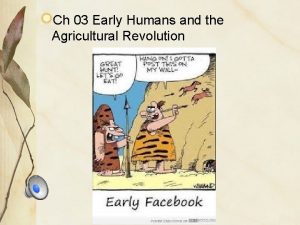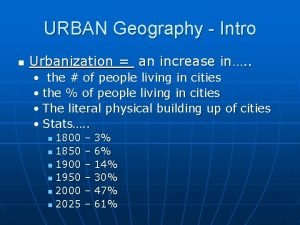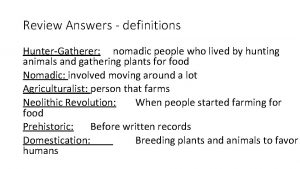Early Humans and Settlements HunterGatherer Early humans lived






- Slides: 6

Early Humans and Settlements

Hunter-Gatherer • Early humans lived in small family groups – around a dozen people • Survived by hunting different animals and gathering wild plants • People often moved: • Ripe plants and animals appeared at different times of the year • Stayed in place for a few days to a few weeks • Shelter was in caves or areas that could give them protection from weather and rival groups • A single family would control/manage a large area of land to provide for everyone

Hunter-Gatherer • Societies were equal due to constant moving and a limited food supply • Older people were probably group leaders • Men would hunt – utilize all parts of the animals • Women would gather plants, fruits, vegetables, and tend to children

Communication • Complex languages developed around 350, 000 to 100, 000 years ago • As groups grew and divided, languages slowly changed • Different sounds • Different hand gestures • Both to show thoughts or emotions • As groups got bigger, they created new items, more words, and more expressions • One theory about different languages argues it is due to environment: • Forests used less vowels and more consonants due to the plants deadening sound waves • Open areas had more vowels to travel further and clearer over large distances

Migration • About 1. 6 million years ago, Earth’s climate cooled after millions of years of warmer conditions • Glaciers moved from the north, creating huge ice sheets that covered much of the northern hemisphere • Sea levels dropped by significant amounts, exposing land that allowed animals and humans to migrate • Ice Age also changed weather patterns, rainfall became less in certain areas, causing deserts • Early hominid migration took hundreds of thousands of years, beginning as early as 2 million years ago • From Africa to Asia – then to Southeast Asia and Europe

Migration • Around 100, 000 years ago, modern humans began to migrate from East Africa to other parts of the world • Early modern humans won out over competition with early hominids over land resources – hominids began disappearing • By about 40, 000 years ago, humans could be found in most of Africa, Europe, and Asia • About 30, 000 years ago, humans migrated to Australia – possibly by a land bridge • Humans also began crossing into the Americas via a land bridge between Asia and present day Alaska • By 10, 000 years ago, humans were in every part of the world (except Antarctica)











